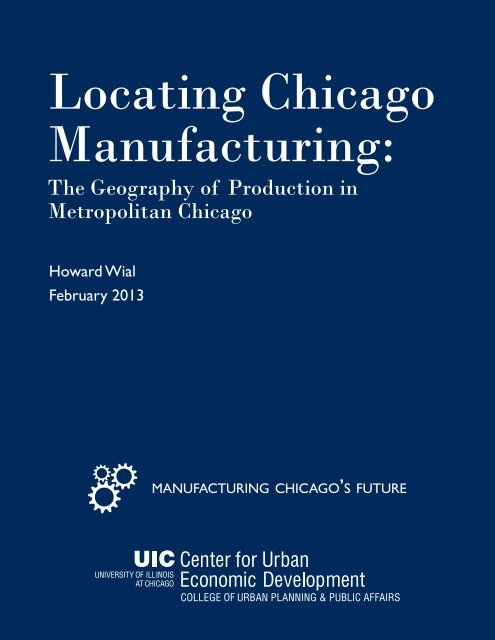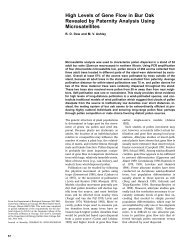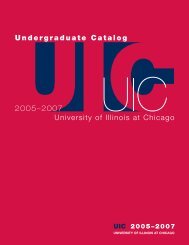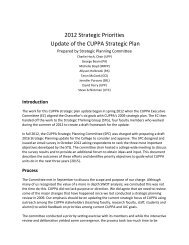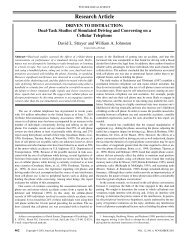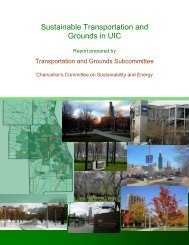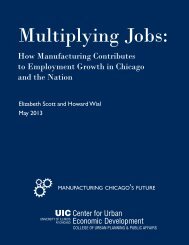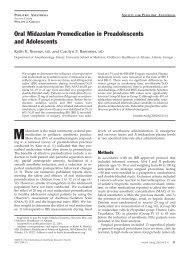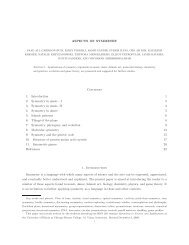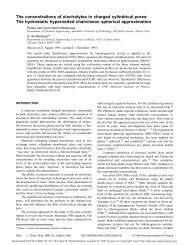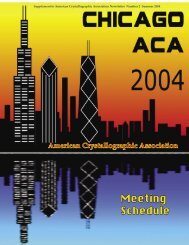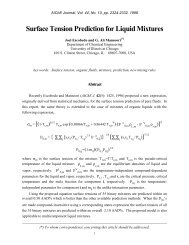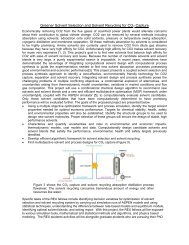Locating Chicago Manufacturing: The Geography of Production in
Locating Chicago Manufacturing: The Geography of Production in
Locating Chicago Manufacturing: The Geography of Production in
Create successful ePaper yourself
Turn your PDF publications into a flip-book with our unique Google optimized e-Paper software.
<strong>Locat<strong>in</strong>g</strong> <strong>Chicago</strong><br />
<strong>Manufactur<strong>in</strong>g</strong>:<br />
<strong>The</strong> <strong>Geography</strong> <strong>of</strong> <strong>Production</strong> <strong>in</strong><br />
Metropolitan <strong>Chicago</strong><br />
Howard Wial<br />
February 2013<br />
manufactur<strong>in</strong>g chicago’s future
february 2013<br />
<strong>Locat<strong>in</strong>g</strong> <strong>Chicago</strong><br />
<strong>Manufactur<strong>in</strong>g</strong>:<br />
<strong>The</strong> <strong>Geography</strong> <strong>of</strong> <strong>Production</strong> <strong>in</strong><br />
Metropolitan <strong>Chicago</strong><br />
Howard Wial 1<br />
Summary<br />
• <strong>The</strong> <strong>Chicago</strong> metropolitan area is one <strong>of</strong> the nation’s major<br />
manufactur<strong>in</strong>g centers, and manufactur<strong>in</strong>g has become a<br />
more important specialization <strong>of</strong> the area over the last decade<br />
despite large manufactur<strong>in</strong>g job losses. In 2011, the <strong>Chicago</strong><br />
metropolitan area had about 411,000 manufactur<strong>in</strong>g jobs, second<br />
only to metropolitan Los Angeles. <strong>Manufactur<strong>in</strong>g</strong>’s percentage <strong>of</strong> all<br />
metropolitan <strong>Chicago</strong> jobs rose from 1.08 times the national percentage<br />
<strong>in</strong> 2001 to 1.11 times that percentage <strong>in</strong> 2011.<br />
• <strong>The</strong> <strong>Chicago</strong> metropolitan area specializes strongly <strong>in</strong> 11<br />
manufactur<strong>in</strong>g <strong>in</strong>dustries, with moderately high technology<br />
<strong>in</strong>dustries more important <strong>in</strong> the region than very high technology<br />
<strong>in</strong>dustries. In 2011, moderately high technology <strong>in</strong>dustries <strong>in</strong><br />
the <strong>Chicago</strong> area accounted for 1.21 times their percentage <strong>of</strong> all jobs<br />
nationwide, while very high technology <strong>in</strong>dustries <strong>in</strong> the metropolitan<br />
area made up less than their national average percentage <strong>of</strong> all jobs.<br />
• Almost half <strong>of</strong> all manufactur<strong>in</strong>g jobs <strong>in</strong> the <strong>Chicago</strong> metropolitan<br />
area are <strong>in</strong> Cook County. About 47 percent <strong>of</strong> the metropolitan<br />
area’s manufactur<strong>in</strong>g jobs are located <strong>in</strong> Cook County: 16<br />
percent <strong>in</strong> the city <strong>of</strong> <strong>Chicago</strong> and 31 percent <strong>in</strong> suburban Cook.<br />
• In metropolitan <strong>Chicago</strong>, manufactur<strong>in</strong>g <strong>of</strong>fers higher wages<br />
than other <strong>in</strong>dustries. In 2011, the average annual earn<strong>in</strong>gs <strong>in</strong> metropolitan<br />
<strong>Chicago</strong> manufactur<strong>in</strong>g jobs were $67,168, about 16 percent<br />
above average annual earn<strong>in</strong>gs for all jobs <strong>in</strong> the metropolitan area.<br />
• Dur<strong>in</strong>g the last two years, metropolitan <strong>Chicago</strong> ga<strong>in</strong>ed<br />
manufactur<strong>in</strong>g jobs more rapidly than the nation as a whole.<br />
From the first quarter <strong>of</strong> 2010, when manufactur<strong>in</strong>g employment hit<br />
its low po<strong>in</strong>t <strong>in</strong> both the metropolitan area and the nation as a whole,<br />
2<br />
manufactur<strong>in</strong>g chicago’s future
through the third quarter <strong>of</strong> 2012, the number <strong>of</strong> manufactur<strong>in</strong>g jobs<br />
<strong>in</strong>creased by 5 percent <strong>in</strong> the <strong>Chicago</strong> area and 4 percent <strong>in</strong> the entire<br />
United States.<br />
february 2013<br />
• Current enthusiasm for local and regional policies to<br />
strengthen manufactur<strong>in</strong>g <strong>in</strong> metropolitan <strong>Chicago</strong> is well<br />
founded. Policy efforts should focus on <strong>in</strong>dustries <strong>in</strong> which the area<br />
already specializes, on new <strong>in</strong>dustries that can be developed from<br />
them, on other <strong>in</strong>dustries that share a skill or technology base with<br />
them, and on promot<strong>in</strong>g high-wage, high-skill production regardless <strong>of</strong><br />
<strong>in</strong>dustry.<br />
Introduction<br />
Recent small ga<strong>in</strong>s <strong>in</strong> manufactur<strong>in</strong>g employment nationwide have led to a resurgence<br />
<strong>of</strong> <strong>in</strong>terest <strong>in</strong> public policies to strengthen America’s manufactur<strong>in</strong>g base.<br />
In his 2013 State <strong>of</strong> <strong>The</strong> Union Address, for example, President Obama pledged<br />
to create three new <strong>Manufactur<strong>in</strong>g</strong> Innovation Institutes to complement the one<br />
that currently exists <strong>in</strong> Youngstown, Ohio, and urged Congress to fund a network<br />
<strong>of</strong> 15 such <strong>in</strong>stitutes. 2 At the metropolitan level, <strong>Chicago</strong> is a leader <strong>in</strong> develop<strong>in</strong>g<br />
creative manufactur<strong>in</strong>g policies and policy proposals. <strong>The</strong> city’s Aust<strong>in</strong> Polytechnical<br />
Academy, founded <strong>in</strong> 2007 by the <strong>Chicago</strong> <strong>Manufactur<strong>in</strong>g</strong> Renaissance<br />
Council, is among the nation’s lead<strong>in</strong>g public high schools focused on manufactur<strong>in</strong>g<br />
and eng<strong>in</strong>eer<strong>in</strong>g. 3 <strong>The</strong> <strong>Chicago</strong> <strong>Manufactur<strong>in</strong>g</strong> Renaissance Council itself<br />
is a unique public-private partnership that has had considerable <strong>in</strong>fluence <strong>in</strong><br />
shap<strong>in</strong>g city policy on manufactur<strong>in</strong>g and <strong>in</strong> <strong>in</strong>itiat<strong>in</strong>g key reforms <strong>in</strong> secondary<br />
and postsecondary education for manufactur<strong>in</strong>g. 4 Mak<strong>in</strong>g <strong>Chicago</strong> a lead<strong>in</strong>g hub<br />
<strong>of</strong> advanced manufactur<strong>in</strong>g is the first <strong>of</strong> 10 strategies <strong>in</strong>cluded <strong>in</strong> the Plan for<br />
Economic Growth and Jobs released last year by World Bus<strong>in</strong>ess <strong>Chicago</strong>, the<br />
city’s nonpr<strong>of</strong>it economic development organization. 5 This year the University<br />
<strong>of</strong> Ill<strong>in</strong>ois announced plans for a privately funded manufactur<strong>in</strong>g-oriented R&D<br />
center to be located <strong>in</strong> <strong>Chicago</strong>. <strong>The</strong> university’s proposed Ill<strong>in</strong>ois <strong>Manufactur<strong>in</strong>g</strong><br />
Lab would give local manufacturers access to computer simulation, workforce<br />
tra<strong>in</strong><strong>in</strong>g, and faculty resources to help them become more <strong>in</strong>novative and competitive.<br />
6<br />
If these <strong>Chicago</strong>-area manufactur<strong>in</strong>g <strong>in</strong>itiatives are to succeed, economic development<br />
policymakers and practitioners should not base their strategies on wishful<br />
th<strong>in</strong>k<strong>in</strong>g or uncritical imitation <strong>of</strong> strategies developed elsewhere. Instead,<br />
they need to understand manufactur<strong>in</strong>g’s place <strong>in</strong> the metropolitan area’s economy,<br />
<strong>in</strong>clud<strong>in</strong>g how important manufactur<strong>in</strong>g is to that economy, which manufactur<strong>in</strong>g<br />
<strong>in</strong>dustries are most important, where manufactur<strong>in</strong>g is located with<strong>in</strong> the<br />
metropolitan area, the wages that manufactur<strong>in</strong>g jobs pay, and how these th<strong>in</strong>gs<br />
have changed <strong>in</strong> recent years. This brief<strong>in</strong>g paper, the first <strong>in</strong> CUED’s Manufactur-<br />
locat<strong>in</strong>g chicago manufactur<strong>in</strong>g<br />
3
february 2013<br />
<strong>in</strong>g <strong>Chicago</strong>’s Future series, provides that basic <strong>in</strong>formation about the geographic<br />
aspects <strong>of</strong> <strong>Chicago</strong>-area manufactur<strong>in</strong>g. It is based on an update <strong>of</strong> the author’s<br />
previous work on the geography <strong>of</strong> U.S. manufactur<strong>in</strong>g, published last year by the<br />
Brook<strong>in</strong>gs Institution. 7<br />
Methodology<br />
This brief<strong>in</strong>g paper covers manufactur<strong>in</strong>g <strong>in</strong> the <strong>Chicago</strong> metropolitan statistical<br />
area, def<strong>in</strong>ed as Cook, DeKalb, DuPage, Grundy, Kane, Kendall, Lake, McHenry,<br />
and Will counties <strong>in</strong> Ill<strong>in</strong>ois; Jasper, Lake, Newton, and Porter counties <strong>in</strong> Indiana;<br />
and Kenosha County <strong>in</strong> Wiscons<strong>in</strong>. <strong>Manufactur<strong>in</strong>g</strong>, as def<strong>in</strong>ed <strong>in</strong> the North<br />
American Industry Classification System (NAICS), <strong>in</strong>cludes only bus<strong>in</strong>ess establishments<br />
primarily engaged <strong>in</strong> the production <strong>of</strong> goods; corporate headquarters<br />
and R&D centers, if not <strong>in</strong> or immediately adjacent to factories, are not<br />
<strong>in</strong>cluded. <strong>The</strong> brief<strong>in</strong>g paper generally classifies manufactur<strong>in</strong>g <strong>in</strong>dustries at the<br />
NAICS three-digit level, but some four-digit <strong>in</strong>dustries that are especially important<br />
to the national economy (motor vehicles and parts, aerospace, and pharmaceuticals)<br />
are considered separately.<br />
<strong>The</strong> paper also analyzes high technology <strong>in</strong>dustries, def<strong>in</strong>ed on the basis <strong>of</strong> the<br />
extent to which they employ science- and eng<strong>in</strong>eer<strong>in</strong>g-related workers nationwide.<br />
Very high technology <strong>in</strong>dustries (computers and electronics, pharmaceuticals,<br />
and aerospace) are those <strong>in</strong> which science and eng<strong>in</strong>eer<strong>in</strong>g occupations<br />
account for at least five times the national average percentage <strong>of</strong> all workers,<br />
while moderately high technology occupations (petroleum and coal products,<br />
chemicals other than pharmaceuticals, transportation equipment other than<br />
autos or aerospace, mach<strong>in</strong>ery, and electrical equipment and appliances) are<br />
those <strong>in</strong> which science and eng<strong>in</strong>eer<strong>in</strong>g occupations make up at least two but<br />
less than five times the national average percentage. 8<br />
Economic development analysts <strong>of</strong>ten use an <strong>in</strong>dustry’s percentage <strong>of</strong> a region’s<br />
jobs as a multiple <strong>of</strong> that <strong>in</strong>dustry’s percentage <strong>of</strong> nationwide jobs to measure<br />
whether the region specializes <strong>in</strong> that <strong>in</strong>dustry. In this brief<strong>in</strong>g paper, the <strong>Chicago</strong><br />
area is considered to specialize strongly <strong>in</strong> a manufactur<strong>in</strong>g <strong>in</strong>dustry if the<br />
<strong>in</strong>dustry’s percentage <strong>of</strong> the metropolitan area’s total employment is at least<br />
1.05 times its percentage <strong>of</strong> nationwide total employment. 9<br />
<strong>The</strong> economic forecast<strong>in</strong>g firm Moody’s Analytics is the source <strong>of</strong> most <strong>of</strong> the<br />
data <strong>in</strong> this brief<strong>in</strong>g paper. However, because Moody’s Analytics does not dist<strong>in</strong>guish<br />
between the city <strong>of</strong> <strong>Chicago</strong> and suburban Cook County, the paper uses<br />
data from the Ill<strong>in</strong>ois Department <strong>of</strong> Employment Security’s “Where Workers<br />
Work” series to estimate the percentages <strong>of</strong> total Cook County manufactur<strong>in</strong>g<br />
employment that are located <strong>in</strong> the city and the suburban areas. 10 <strong>The</strong> data <strong>in</strong><br />
“Where Workers Work” are generally very comparable to the Moody’s Analytics<br />
data; where they are not, separate data for the city <strong>of</strong> <strong>Chicago</strong> and suburban<br />
Cook County are not presented. <strong>The</strong> brief<strong>in</strong>g paper provides <strong>in</strong>formation for<br />
4<br />
manufactur<strong>in</strong>g chicago’s future
the year 2011, the most recent full year for which Moody’s Analytics data are<br />
available. In mak<strong>in</strong>g comparisons over time, the paper also uses data for selected<br />
earlier years and more recent quarterly data.<br />
<strong>The</strong> Brook<strong>in</strong>gs Institution report “<strong>Locat<strong>in</strong>g</strong> American <strong>Manufactur<strong>in</strong>g</strong>: Trends <strong>in</strong> the<br />
<strong>Geography</strong> <strong>of</strong> <strong>Production</strong>” provides additional methodological details. 11<br />
february 2013<br />
F<strong>in</strong>d<strong>in</strong>gs<br />
A. <strong>The</strong> <strong>Chicago</strong> metropolitan area is one <strong>of</strong> the nation’s major manufactur<strong>in</strong>g<br />
centers, and manufactur<strong>in</strong>g has become a more important<br />
specialization <strong>of</strong> the area over the last decade despite large manufactur<strong>in</strong>g<br />
job losses.<br />
<strong>The</strong> <strong>Chicago</strong> area has a large number <strong>of</strong> manufactur<strong>in</strong>g jobs, and these make up<br />
an important part <strong>of</strong> the metropolitan area’s economy. In 2011, the <strong>Chicago</strong><br />
metropolitan area had about 411,000 manufactur<strong>in</strong>g jobs, second only to metropolitan<br />
Los Angeles. <strong>Manufactur<strong>in</strong>g</strong> also accounts for a disproportionately high<br />
percentage <strong>of</strong> the metropolitan area’s total employment. In 2011 manufactur<strong>in</strong>g<br />
made up 9.5 percent <strong>of</strong> all <strong>Chicago</strong>-area jobs, compared to only 8.5 percent<br />
<strong>of</strong> jobs nationwide. Thus, manufactur<strong>in</strong>g’s percentage <strong>of</strong> <strong>Chicago</strong>-area jobs was<br />
1.11 times its percentage <strong>of</strong> all U.S. jobs. This <strong>in</strong>dicates that metropolitan <strong>Chicago</strong><br />
has a strong specialization <strong>in</strong> manufactur<strong>in</strong>g compared to the nation as a<br />
whole.<br />
Despite the huge loss <strong>of</strong> manufactur<strong>in</strong>g jobs that the <strong>Chicago</strong> area suffered<br />
dur<strong>in</strong>g the first decade <strong>of</strong> the 21 st century, manufactur<strong>in</strong>g is, paradoxically, more<br />
important as an economic specialization <strong>in</strong> metropolitan <strong>Chicago</strong> now than it<br />
was a decade ago. <strong>The</strong> metropolitan area had about 185,000 fewer manufactur<strong>in</strong>g<br />
jobs <strong>in</strong> 2011 than <strong>in</strong> 2001, and manufactur<strong>in</strong>g’s percentage <strong>of</strong> all <strong>Chicago</strong>-area<br />
jobs fell from 12.9 percent to 9.5 percent dur<strong>in</strong>g this time. Yet manufactur<strong>in</strong>g’s<br />
percentage <strong>of</strong> all U.S. jobs fell even faster, from 12.0 percent to 8.5 percent. Thus,<br />
manufactur<strong>in</strong>g’s percentage <strong>of</strong> all metropolitan <strong>Chicago</strong> jobs rose from 1.08 times<br />
the national percentage <strong>in</strong> 2001 to 1.11 times that percentage <strong>in</strong> 2011. <strong>The</strong> metropolitan<br />
area became more specialized <strong>in</strong> manufactur<strong>in</strong>g even as it lost manufactur<strong>in</strong>g<br />
jobs.<br />
B. <strong>The</strong> <strong>Chicago</strong> metropolitan area specializes strongly <strong>in</strong> 11 manufactur<strong>in</strong>g<br />
<strong>in</strong>dustries, with moderately high technology <strong>in</strong>dustries more<br />
important <strong>in</strong> the region than very high technology <strong>in</strong>dustries.<br />
Metropolitan <strong>Chicago</strong>’s manufactur<strong>in</strong>g base, like that <strong>of</strong> many <strong>of</strong> the nation’s 100<br />
largest metropolitan areas, is diverse. Figure 1 shows the <strong>in</strong>dustry composition<br />
<strong>of</strong> the <strong>Chicago</strong> area’s manufactur<strong>in</strong>g jobs. <strong>The</strong> metropolitan area’s largest manufactur<strong>in</strong>g<br />
<strong>in</strong>dustries are fabricated metal products, whose approximately 66,000<br />
jobs make up 16 percent <strong>of</strong> the area’s manufactur<strong>in</strong>g jobs, and food manufactur<strong>in</strong>g,<br />
locat<strong>in</strong>g chicago manufactur<strong>in</strong>g<br />
5
february 2013<br />
with about 48,000 jobs, about 12 percent <strong>of</strong> all manufactur<strong>in</strong>g jobs <strong>in</strong> the area.<br />
<strong>The</strong> manufactur<strong>in</strong>g <strong>in</strong>dustries with the most jobs, however, are not the same as the<br />
ones <strong>in</strong> which the metropolitan area specializes, s<strong>in</strong>ce some <strong>in</strong>dustries that are large<br />
<strong>in</strong> <strong>Chicago</strong> are also large nationwide. Figure 2 shows the 11 manufactur<strong>in</strong>g <strong>in</strong>dustries<br />
<strong>in</strong> which the <strong>Chicago</strong> metropolitan area strongly specializes. <strong>The</strong>se <strong>in</strong>dustries<br />
are the ones that are most important to the metropolitan area’s manufactur<strong>in</strong>g base.<br />
Figure 1. Industry Composition <strong>of</strong> Metropolitan <strong>Chicago</strong> <strong>Manufactur<strong>in</strong>g</strong> Jobs, 2011<br />
Transportation Equipment 4%<br />
Paper 4%<br />
Food 12%<br />
Electrical Equipment 5%<br />
and Appliances<br />
Other <strong>Manufactur<strong>in</strong>g</strong><br />
13%<br />
Pr<strong>in</strong>t<strong>in</strong>g and Related<br />
Support Activities 6%<br />
Non-Pharmaceutical<br />
Chemicals 5%<br />
Plastics and Rubber<br />
Products 7%<br />
Miscellaneous<br />
<strong>Manufactur<strong>in</strong>g</strong> 6%<br />
Primary Metals 7%<br />
Computer and<br />
Electronic Products 7%<br />
Mach<strong>in</strong>ery 9%<br />
Fabricated Metal<br />
Products 16%<br />
Notes: “Transportation equipment” <strong>in</strong>cludes all motor vehicles and parts, aerospace, and rail and other transportation equipment.<br />
“Miscellaneous manufactur<strong>in</strong>g” consists <strong>of</strong> a variety <strong>of</strong> <strong>in</strong>dustries that are not part <strong>of</strong> other <strong>in</strong>dustry categories. It <strong>in</strong>cludes, among other<br />
th<strong>in</strong>gs, some medical devices, jewelry, silverware, toys, signs, and <strong>of</strong>fice supplies.<br />
“Other manufactur<strong>in</strong>g” <strong>in</strong>cludes furniture, wood products, beverage and tobacco products, pharmaceuticals, petroleum and coal products,<br />
nonmetallic m<strong>in</strong>eral products, apparel, textile and textile product mills, and leather.<br />
Source: Author’s analysis <strong>of</strong> Moody’s Analytics data.<br />
6<br />
manufactur<strong>in</strong>g chicago’s future
Although the metropolitan area specializes strongly <strong>in</strong> pharmaceuticals, a very<br />
high technology <strong>in</strong>dustry, it does not specialize strongly <strong>in</strong> very high technology<br />
manufactur<strong>in</strong>g <strong>in</strong>dustries <strong>in</strong> general. (In addition to pharmaceuticals, very high<br />
technology <strong>in</strong>dustries <strong>in</strong>clude aerospace and computers and electronics.) However,<br />
it does specialize strongly <strong>in</strong> moderately high technology <strong>in</strong>dustries, especially<br />
electrical equipment and appliances, chemicals (other than pharmaceuticals),<br />
and mach<strong>in</strong>ery. In 2011, moderately high technology <strong>in</strong>dustries <strong>in</strong> the <strong>Chicago</strong><br />
area accounted for 1.21 times their percentage <strong>of</strong> all jobs nationwide, while very<br />
high technology <strong>in</strong>dustries <strong>in</strong> the metropolitan area made up less than their national<br />
average percentage <strong>of</strong> all jobs.<br />
february 2013<br />
Figure 2. Metropolitan <strong>Chicago</strong>’s Strong <strong>Manufactur<strong>in</strong>g</strong> Industry Specializations, 2011<br />
2.50<br />
2.21<br />
2.00<br />
2.00<br />
Specialization*<br />
1.50<br />
1.00<br />
1.68<br />
1.56 1.52 1.50<br />
1.40 1.37<br />
1.29 1.27<br />
1.17<br />
1.11<br />
0.77<br />
1.21<br />
0.50<br />
Primary Metals<br />
Pharmaceuticals<br />
Electrical Equipment and Appliances<br />
Fabricated Metal Products<br />
Pr<strong>in</strong>t<strong>in</strong>g<br />
Plastics and Rubber Products<br />
Paper<br />
Miscellaneous <strong>Manufactur<strong>in</strong>g</strong><br />
Non-Pharmaceutical Chemicals<br />
Petroleum and Coal Products<br />
Mach<strong>in</strong>ery<br />
All <strong>Manufactur<strong>in</strong>g</strong><br />
Very High Technology<br />
Moderately High Technology<br />
*Industry’s percentage <strong>of</strong> all metropolitan <strong>Chicago</strong> jobs as multiple <strong>of</strong> its percentage <strong>of</strong> all U.S. jobs.<br />
Source: Author’s analysis <strong>of</strong> Moody’s Analytics data.<br />
locat<strong>in</strong>g chicago manufactur<strong>in</strong>g<br />
7
february 2013<br />
Figure 3. Industry Composition <strong>of</strong> City <strong>of</strong> <strong>Chicago</strong> <strong>Manufactur<strong>in</strong>g</strong> Jobs, 2011<br />
Furniture and Related Products 5%<br />
Mach<strong>in</strong>ery 4%<br />
Chemicals 4%<br />
Food 26%<br />
Other<br />
<strong>Manufactur<strong>in</strong>g</strong> 17%<br />
Paper 6%<br />
Miscellaneous<br />
<strong>Manufactur<strong>in</strong>g</strong> 6%<br />
Transportation<br />
Equipment 7%<br />
Pr<strong>in</strong>t<strong>in</strong>g and Related<br />
Support Activities 6%<br />
Electrical Equipment 5%<br />
and Appliances<br />
Fabricated Metal Products 15%<br />
Notes: “Transportation equipment” <strong>in</strong>cludes all motor vehicles and parts, aerospace, and rail and other transportation equipment.<br />
“Chemicals” <strong>in</strong>cludes both pharmaceuticals and non-pharmaceutical chemicals.<br />
“Miscellaneous manufactur<strong>in</strong>g” consists <strong>of</strong> a variety <strong>of</strong> <strong>in</strong>dustries that are not part <strong>of</strong> other <strong>in</strong>dustry categories. It <strong>in</strong>cludes, among other<br />
th<strong>in</strong>gs, some medical devices, jewelry, silverware, toys, signs, and <strong>of</strong>fice supplies.<br />
“Other manufactur<strong>in</strong>g” <strong>in</strong>cludes wood products, beverage and tobacco products, petroleum and coal products, nonmetallic m<strong>in</strong>eral products,<br />
primary metals, plastics and rubber products, computer and electronic products, apparel, textile and textile product mills, and leather.<br />
Source: Author’s analysis <strong>of</strong> Moody’s Analytics data.<br />
8<br />
manufactur<strong>in</strong>g chicago’s future
<strong>The</strong> city <strong>of</strong> <strong>Chicago</strong> has a dist<strong>in</strong>ctive manufactur<strong>in</strong>g <strong>in</strong>dustry pr<strong>of</strong>ile. Figure 3<br />
shows the <strong>in</strong>dustry composition <strong>of</strong> the city’s approximately 65,000 manufactur<strong>in</strong>g<br />
jobs. <strong>The</strong> city’s largest manufactur<strong>in</strong>g <strong>in</strong>dustries are food manufactur<strong>in</strong>g, with 26<br />
percent <strong>of</strong> the city’s manufactur<strong>in</strong>g jobs, and fabricated metal products, with 15<br />
percent.<br />
february 2013<br />
Figure 4 shows the manufactur<strong>in</strong>g <strong>in</strong>dustries <strong>in</strong> which the city strongly specializes.<br />
<strong>The</strong>se specializations differ greatly from those <strong>of</strong> the metropolitan area. Only<br />
paper and electrical equipment and appliances are strong specializations <strong>of</strong> both<br />
the city and the entire metropolitan area.<br />
Figure 4. <strong>The</strong> City <strong>of</strong> <strong>Chicago</strong>’s Strong <strong>Manufactur<strong>in</strong>g</strong> Industry Specializations, 2011<br />
1.80<br />
Specialization*<br />
1.60<br />
1.40<br />
1.20<br />
1.00<br />
0.80<br />
1.55<br />
1.48<br />
1.43 1.42<br />
1.27<br />
1.24<br />
1.18<br />
0.74<br />
0.60<br />
0.40<br />
0.20<br />
Food<br />
Textile Product Mills<br />
Apparel<br />
Leather<br />
Electrical Equipment and Appliances<br />
Paper<br />
Furniture<br />
All <strong>Manufactur<strong>in</strong>g</strong><br />
*Industry’s percentage <strong>of</strong> all metropolitan <strong>Chicago</strong> jobs as multiple <strong>of</strong> its percentage <strong>of</strong> all U.S. jobs.<br />
Note: Very and moderately high technology manufactur<strong>in</strong>g job estimates are not available for the city <strong>of</strong> <strong>Chicago</strong>.<br />
Source: Author’s analysis <strong>of</strong> Moody’s Analytics data.<br />
locat<strong>in</strong>g chicago manufactur<strong>in</strong>g<br />
9
february 2013<br />
Figure 5. <strong>Manufactur<strong>in</strong>g</strong> Jobs <strong>in</strong> <strong>Chicago</strong> Metropolitan Area Counties and the<br />
City <strong>of</strong> <strong>Chicago</strong>, 2011<br />
Kenosha<br />
County (WI)<br />
6,610<br />
McHenry<br />
County<br />
Lake<br />
County (IL)<br />
15,522<br />
48,369<br />
DeKalb<br />
County<br />
4,013<br />
Kane<br />
County<br />
30,278<br />
Suburban<br />
Cook County<br />
DuPage<br />
County<br />
50,871<br />
<strong>Chicago</strong><br />
City<br />
65,421<br />
Kendall<br />
County<br />
3,955<br />
Grundy<br />
County<br />
Will<br />
County<br />
20,200<br />
129,232<br />
Lake<br />
County<br />
(IN)<br />
24,015<br />
Porter<br />
County<br />
(IN)<br />
9,198<br />
<strong>Manufactur<strong>in</strong>g</strong><br />
Employment, 2011<br />
800 - 1,400<br />
1,401 - 10,000<br />
10,001 - 30,000<br />
30,001 - 70,000<br />
1,371<br />
Source: Author’s analysis <strong>of</strong> Moody’s Analytics data.<br />
Newton<br />
County<br />
(IN)<br />
810<br />
Jasper<br />
County<br />
(IN)<br />
1,350<br />
70,001 - 130,000<br />
Miles<br />
0 5 10 20 30 40<br />
10<br />
manufactur<strong>in</strong>g chicago’s future
C. Almost half <strong>of</strong> all manufactur<strong>in</strong>g jobs <strong>in</strong> the <strong>Chicago</strong> metropolitan<br />
area are <strong>in</strong> Cook County.<br />
About 47 percent <strong>of</strong> the metropolitan area’s manufactur<strong>in</strong>g jobs are located <strong>in</strong><br />
Cook County: 16 percent <strong>in</strong> the city <strong>of</strong> <strong>Chicago</strong> and 31 percent <strong>in</strong> suburban<br />
Cook. <strong>The</strong> only other counties <strong>in</strong> the area with at least 5 percent <strong>of</strong> the metropolitan<br />
manufactur<strong>in</strong>g total are DuPage (12 percent), Lake (Ill<strong>in</strong>ois) (12 percent),<br />
Kane (7 percent), and Lake (Indiana) (6 percent). Figure 5 shows the number <strong>of</strong><br />
manufactur<strong>in</strong>g jobs <strong>in</strong> each county and <strong>in</strong> the city <strong>of</strong> <strong>Chicago</strong>.<br />
february 2013<br />
Some <strong>of</strong> the <strong>Chicago</strong> area’s strong manufactur<strong>in</strong>g <strong>in</strong>dustry specializations have<br />
very different geographic patterns than manufactur<strong>in</strong>g as a whole.<br />
• About 85 percent <strong>of</strong> the area’s pharmaceutical manufactur<strong>in</strong>g jobs are <strong>in</strong><br />
Lake County, Ill<strong>in</strong>ois, reflect<strong>in</strong>g the presence there <strong>of</strong> several major pharmaceutical<br />
companies. Miscellaneous manufactur<strong>in</strong>g, which <strong>in</strong>cludes a substantial part <strong>of</strong><br />
medical device manufactur<strong>in</strong>g, also has a large presence <strong>in</strong> Lake County (23 percent<br />
<strong>of</strong> the <strong>in</strong>dustry’s jobs are located there), although the <strong>in</strong>dustry’s geographic<br />
pattern is otherwise similar to that <strong>of</strong> manufactur<strong>in</strong>g as a whole.<br />
• Petroleum and coal products jobs (ma<strong>in</strong>ly <strong>in</strong> oil ref<strong>in</strong>eries) are located<br />
largely <strong>in</strong> Lake County, Indiana, which has 41 percent <strong>of</strong> those jobs; suburban<br />
Cook County has another 26 percent.<br />
• Nearly half (47 percent) <strong>of</strong> the area’s jobs <strong>in</strong> primary metal manufactur<strong>in</strong>g<br />
(ma<strong>in</strong>ly steel manufactur<strong>in</strong>g) are <strong>in</strong> Lake County, Indiana; another 20 percent are<br />
<strong>in</strong> adjo<strong>in</strong><strong>in</strong>g Porter County and 14 percent are <strong>in</strong> suburban Cook.<br />
• Large majorities <strong>of</strong> pr<strong>in</strong>t<strong>in</strong>g, paper, and electrical equipment and appliance<br />
manufactur<strong>in</strong>g jobs are located <strong>in</strong> Cook County (54 percent <strong>of</strong> pr<strong>in</strong>t<strong>in</strong>g jobs, 57<br />
percent <strong>of</strong> paper jobs, and 60 percent <strong>of</strong> electrical equipment and appliances<br />
jobs), with most <strong>of</strong> those <strong>in</strong> suburban Cook. DuPage County also has substantial<br />
numbers <strong>of</strong> jobs <strong>in</strong> all three <strong>in</strong>dustries.<br />
• Will County has 12 percent <strong>of</strong> the area’s jobs <strong>in</strong> chemical (other than<br />
pharmaceutical) manufactur<strong>in</strong>g. This <strong>in</strong>dustry’s geographic pattern is otherwise<br />
similar to that <strong>of</strong> manufactur<strong>in</strong>g as a whole.<br />
<strong>The</strong>re are two regionally important <strong>in</strong>dustries <strong>in</strong> which the city <strong>of</strong> <strong>Chicago</strong> has a<br />
disproportionately large number <strong>of</strong> jobs. Although the city has only 16 percent<br />
<strong>of</strong> all the metropolitan area’s manufactur<strong>in</strong>g jobs, it has 21 percent <strong>of</strong> jobs <strong>in</strong> paper<br />
and 18 percent <strong>of</strong> jobs <strong>in</strong> electrical equipment and appliances.<br />
locat<strong>in</strong>g chicago manufactur<strong>in</strong>g<br />
11
D. In metropolitan <strong>Chicago</strong>, manufactur<strong>in</strong>g <strong>of</strong>fers higher wages<br />
than other <strong>in</strong>dustries.<br />
february 2013<br />
In 2011, the average annual earn<strong>in</strong>gs (exclud<strong>in</strong>g employee benefits) <strong>in</strong> metropolitan<br />
<strong>Chicago</strong> manufactur<strong>in</strong>g were $67,168, about 16 percent above the $56,579<br />
overall average earn<strong>in</strong>gs for all jobs <strong>in</strong> the metropolitan area. <strong>Manufactur<strong>in</strong>g</strong>’s<br />
wage advantage reflects a variety <strong>of</strong> factors, <strong>in</strong>clud<strong>in</strong>g differences <strong>in</strong> workforce<br />
demographics and unionization, but the ma<strong>in</strong> reason why manufacturers pay high<br />
wages is to attract and ma<strong>in</strong>ta<strong>in</strong> a workforce that is skilled and motivated to<br />
avoid the costs <strong>of</strong> downtime and take some responsibility for self-management. 12<br />
Metropolitan <strong>Chicago</strong>’s manufactur<strong>in</strong>g wages are high not only compared to<br />
wages <strong>in</strong> the rest <strong>of</strong> the metropolitan area’s economy but also compared to<br />
manufactur<strong>in</strong>g wages <strong>in</strong> the rest <strong>of</strong> the United States. <strong>Chicago</strong>-area average<br />
manufactur<strong>in</strong>g earn<strong>in</strong>gs exceeded the U.S. manufactur<strong>in</strong>g average ($60,340) by<br />
11 percent. <strong>Manufactur<strong>in</strong>g</strong> wages are high <strong>in</strong> the <strong>Chicago</strong> area for two reasons.<br />
First, high-wage <strong>in</strong>dustries are more important <strong>in</strong> the <strong>Chicago</strong> area than nationwide.<br />
If metropolitan <strong>Chicago</strong> had had the same <strong>in</strong>dustry composition as the<br />
nation as a whole (but the same average earn<strong>in</strong>gs <strong>in</strong> each <strong>in</strong>dustry as it actually<br />
had), its 2011 average earn<strong>in</strong>gs would have been $65,613 per year rather than<br />
$67,168. Second, <strong>in</strong>dividual <strong>in</strong>dustries <strong>of</strong>fer higher wages <strong>in</strong> the <strong>Chicago</strong> area<br />
than <strong>in</strong> the nation as a whole. In 17 <strong>of</strong> the 24 manufactur<strong>in</strong>g <strong>in</strong>dustries covered<br />
<strong>in</strong> this report (all except beverage and tobacco products, textile mills, textile<br />
product mills, apparel, paper, computers and electronics, and aerospace), average<br />
annual earn<strong>in</strong>gs <strong>in</strong> the <strong>Chicago</strong> metropolitan area exceeded their respective<br />
national averages. Differences <strong>in</strong> wages between metropolitan areas, even with<strong>in</strong><br />
the same <strong>in</strong>dustry, reflect differences <strong>in</strong> education and skill, products and processes,<br />
and worker barga<strong>in</strong><strong>in</strong>g power. 13<br />
Not all manufactur<strong>in</strong>g <strong>in</strong>dustries <strong>of</strong>fer high wages, though. Average annual earn<strong>in</strong>gs<br />
<strong>in</strong> the <strong>Chicago</strong> metropolitan area’s highest-wage manufactur<strong>in</strong>g <strong>in</strong>dustry,<br />
petroleum and coal products, were nearly $117,000. This was 3.75 times the<br />
$31,208 average earn<strong>in</strong>gs <strong>in</strong> the area’s lowest-wage manufactur<strong>in</strong>g <strong>in</strong>dustry, textile<br />
product mills.<br />
Table 1 shows the average annual earn<strong>in</strong>gs <strong>in</strong> each <strong>of</strong> metropolitan <strong>Chicago</strong>’s<br />
manufactur<strong>in</strong>g <strong>in</strong>dustries. <strong>The</strong> table shows that the <strong>in</strong>dustries <strong>in</strong> which the metropolitan<br />
area has a strong specialization (shown with the blue cog) are evenly<br />
split between those with average earn<strong>in</strong>gs above the metropolitan manufactur<strong>in</strong>g<br />
average and those with average earn<strong>in</strong>gs somewhat below that average; none<br />
<strong>of</strong> the metropolitan area’s strong manufactur<strong>in</strong>g <strong>in</strong>dustry specializations is a<br />
very low-wage <strong>in</strong>dustry. Most <strong>of</strong> those <strong>in</strong> which the city <strong>of</strong> <strong>Chicago</strong> specializes<br />
(shown with the red dotted cog) have average earn<strong>in</strong>gs below (<strong>in</strong> some cases,<br />
substantially below) that average.<br />
12<br />
manufactur<strong>in</strong>g chicago’s future
E. Dur<strong>in</strong>g the last two years, metropolitan <strong>Chicago</strong> ga<strong>in</strong>ed manufactur<strong>in</strong>g<br />
jobs more rapidly than the nation as a whole.<br />
S<strong>in</strong>ce the beg<strong>in</strong>n<strong>in</strong>g <strong>of</strong> 2010, the numbers <strong>of</strong> manufactur<strong>in</strong>g jobs <strong>in</strong> metropolitan<br />
<strong>Chicago</strong> and the entire United States have begun to rise after a decade <strong>of</strong> unprecedented<br />
decl<strong>in</strong>e. This growth is only partly the result <strong>of</strong> a “bounce-back” <strong>of</strong><br />
demand after the Great Recession; it also reflects longer-term factors such as<br />
ris<strong>in</strong>g wages <strong>in</strong> Ch<strong>in</strong>a and is, therefore, likely to cont<strong>in</strong>ue. 14 <strong>The</strong> recent growth<br />
<strong>of</strong> manufactur<strong>in</strong>g jobs has been slightly faster <strong>in</strong> the <strong>Chicago</strong> area than nationwide.<br />
From the first quarter <strong>of</strong> 2010, when manufactur<strong>in</strong>g employment hit its<br />
low po<strong>in</strong>t <strong>in</strong> both the metropolitan area and the nation as a whole, through the<br />
third quarter <strong>of</strong> 2012 (the last quarter for which data are available), the number<br />
<strong>of</strong> manufactur<strong>in</strong>g jobs <strong>in</strong>creased by 5 percent <strong>in</strong> the <strong>Chicago</strong> area and 4 percent<br />
<strong>in</strong> the entire United States. This was not a consequence <strong>of</strong> more rapid overall<br />
job growth <strong>in</strong> the <strong>Chicago</strong> area; <strong>in</strong> fact, total employment rose by only 2 percent<br />
<strong>in</strong> the metropolitan area dur<strong>in</strong>g this period, compared to 3 percent nationwide.<br />
february 2013<br />
Table 1. Average Annual Earn<strong>in</strong>gs <strong>in</strong> Metropolitan <strong>Chicago</strong> <strong>Manufactur<strong>in</strong>g</strong> Industries, 2011<br />
Industry<br />
Average Annual Earn<strong>in</strong>gs<br />
Petroleum and Coal Products $116,983<br />
Parmaceuticals $116,259<br />
Primary Metals $83,452<br />
Mach<strong>in</strong>ery $82,007<br />
Chemicals (Non-Pharmaceutical) $81,699<br />
Aerospace $79,350<br />
Computers and Electronics $76,352<br />
Rail and Other Transportation Equipment $74,622<br />
Miscellaneous <strong>Manufactur<strong>in</strong>g</strong> $74,028<br />
Motor Vehicles and Parts $69,452<br />
all manufactur<strong>in</strong>g $67,178<br />
Electrical Equipment and Appliances $62,862<br />
Paper $60,017<br />
Fabricated Metals $56,689<br />
Plastics and Rubber Products $55,830<br />
Nonmetallic M<strong>in</strong>eral Products $55,788<br />
Pr<strong>in</strong>t<strong>in</strong>g $54,507<br />
Food $52,630<br />
Furniture $49,241<br />
Beverage and Tobacco Products $49,035<br />
Leather $47,531<br />
Wood Products $39,350<br />
Textile Mills $38,231<br />
Apparel $33,241<br />
Textile Product Mills $31,208<br />
Strong<br />
Specialization<br />
<strong>of</strong> the <strong>Chicago</strong><br />
Metropolian<br />
Area<br />
Strong<br />
Specialization<br />
<strong>of</strong> the City <strong>of</strong><br />
<strong>Chicago</strong><br />
Source: Author’s analysis<br />
<strong>of</strong> Moody’s Analytics data.<br />
locat<strong>in</strong>g chicago manufactur<strong>in</strong>g<br />
13
february 2013<br />
In the United States as a whole, recent manufactur<strong>in</strong>g job growth has occurred<br />
ma<strong>in</strong>ly <strong>in</strong> durable goods <strong>in</strong>dustries, especially mach<strong>in</strong>ery, fabricated metal products,<br />
and transportation equipment; nondurable goods employment as a whole cont<strong>in</strong>ued<br />
to decl<strong>in</strong>e, and the only nondurable <strong>in</strong>dustry to experience rapid job growth<br />
Figure 6. Percent Change <strong>in</strong> <strong>Manufactur<strong>in</strong>g</strong> Jobs, by Industry, Metropolitan <strong>Chicago</strong><br />
and the United States, 1st Quarter 2010-3rd Quarter 2012<br />
<strong>Chicago</strong> Metropolitan Area<br />
United States<br />
Rail and Other Transportation Equipment<br />
Apparel<br />
Motor Vehicles and Parts<br />
Leather<br />
Textile Product Mills<br />
Aerospace<br />
Beverage and Tobacco Products<br />
Nonmetallic M<strong>in</strong>erals<br />
Petroleum and Coal Products<br />
Textile Mills<br />
Fabricated Metal Products<br />
Primary Metals<br />
Electrical Equipment and Appliances<br />
Mach<strong>in</strong>ery<br />
Food<br />
Wood Products<br />
Miscellaneous <strong>Manufactur<strong>in</strong>g</strong><br />
Plastics and Rubber Products<br />
Chemicals (Non-Pharmaceutical)<br />
Paper<br />
Pharmaceuticals<br />
Furniture<br />
Computer and Electronic Products<br />
Pr<strong>in</strong>t<strong>in</strong>g<br />
All <strong>Manufactur<strong>in</strong>g</strong><br />
Source: Author’s analysis <strong>of</strong> Moody’s Analytics data.<br />
-10% 0% 10% 20% 30% 40% 50% 60%<br />
14<br />
manufactur<strong>in</strong>g chicago’s future
was leather products. <strong>Manufactur<strong>in</strong>g</strong> job growth <strong>in</strong> the <strong>Chicago</strong> area has been<br />
more broadly based, with many nondurable goods <strong>in</strong>dustries (beverage and tobacco<br />
products, textile mills, textile product mills, apparel, petroleum and coal products,<br />
and leather products) as well as several durable goods <strong>in</strong>dustries (nonmetallic m<strong>in</strong>eral<br />
products, fabricated metal products, and transportation equipment) experienc<strong>in</strong>g<br />
double-digit job growth. Even <strong>in</strong> <strong>in</strong>dustries with slower recent job growth or<br />
job losses, metropolitan <strong>Chicago</strong>’s job performance generally exceeded that <strong>of</strong> the<br />
entire United States dur<strong>in</strong>g the last two years (figure 6).<br />
february 2013<br />
Most <strong>of</strong> the strong <strong>in</strong>dustry specializations <strong>of</strong> the metropolitan area and the city <strong>of</strong><br />
<strong>Chicago</strong> experienced job growth dur<strong>in</strong>g the last two years. However, both pharmaceuticals<br />
and chemicals (other than pharmaceuticals) lost jobs, as did paper, pr<strong>in</strong>t<strong>in</strong>g,<br />
and furniture. Some other important <strong>Chicago</strong>-area <strong>in</strong>dustry specializations (plastics<br />
and rubber products, primary metals, mach<strong>in</strong>ery, and miscellaneous manufactur<strong>in</strong>g)<br />
ga<strong>in</strong>ed jobs, but more slowly than the nation as a whole.<br />
<strong>The</strong> metropolitan area’s job growth <strong>in</strong> high technology manufactur<strong>in</strong>g <strong>in</strong>dustries<br />
also lagged that <strong>of</strong> the nation dur<strong>in</strong>g the last two years. Very high technology <strong>in</strong>dustries<br />
lost jobs <strong>in</strong> the <strong>Chicago</strong> area while ga<strong>in</strong><strong>in</strong>g jobs nationwide. Moderately high<br />
technology <strong>in</strong>dustries grew more slowly <strong>in</strong> metropolitan <strong>Chicago</strong> than <strong>in</strong> the entire<br />
United States.<br />
Recent manufactur<strong>in</strong>g job growth has not come close to mak<strong>in</strong>g up for huge manufactur<strong>in</strong>g<br />
job losses dur<strong>in</strong>g the previous decade. Despite the recent growth, the<br />
number <strong>of</strong> manufactur<strong>in</strong>g jobs rema<strong>in</strong>ed 29 percent lower <strong>in</strong> the third quarter <strong>of</strong><br />
2012 then <strong>in</strong> 2001 <strong>in</strong> metropolitan <strong>Chicago</strong> and 27 percent lower <strong>in</strong> the nation as a<br />
whole.<br />
Between 2001 and 2010, the metropolitan area lost 32 percent <strong>of</strong> its manufactur<strong>in</strong>g<br />
jobs, a slightly higher percentage than the nationwide 30 percent loss. Geographically,<br />
losses were more severe <strong>in</strong> the central part <strong>of</strong> the metropolitan area (the city<br />
<strong>of</strong> <strong>Chicago</strong> and suburban Cook County) than <strong>in</strong> outly<strong>in</strong>g areas, although some outly<strong>in</strong>g<br />
counties also had very severe losses. Thus, the geographic pattern <strong>of</strong> manufactur<strong>in</strong>g<br />
job loss <strong>in</strong> metropolitan <strong>Chicago</strong>, as <strong>in</strong> the nation as a whole, resulted <strong>in</strong> the<br />
decentralization <strong>of</strong> manufactur<strong>in</strong>g away from its historic core areas. 15<br />
Losses were most severe <strong>in</strong> Newton County, Indiana, which lost 48 percent <strong>of</strong> its<br />
manufactur<strong>in</strong>g jobs between 2001 and 2010, followed by the city <strong>of</strong> <strong>Chicago</strong> (47<br />
percent), Kenosha County, Wiscons<strong>in</strong> (44 percent), DeKalb County (35 percent),<br />
and suburban Cook County (35 percent). Losses were much more modest <strong>in</strong> Lake<br />
County, Ill<strong>in</strong>ois (16 percent) and Porter County, Indiana (19 percent). Only Will<br />
County ga<strong>in</strong>ed manufactur<strong>in</strong>g jobs (by 1.9 percent) dur<strong>in</strong>g this time.<br />
<strong>The</strong> manufactur<strong>in</strong>g <strong>in</strong>dustries that lost the highest percentages <strong>of</strong> their jobs <strong>in</strong> the<br />
<strong>Chicago</strong> area between 2001 and 2010 were leather and apparel, both <strong>of</strong> which lost<br />
more than half their jobs. Most other manufactur<strong>in</strong>g <strong>in</strong>dustries had percentage job<br />
losses above the metropolitan area average (figure 7). Only food manufactur<strong>in</strong>g,<br />
miscellaneous manufactur<strong>in</strong>g, and pharmaceutical manufactur<strong>in</strong>g experienced losses<br />
locat<strong>in</strong>g chicago manufactur<strong>in</strong>g<br />
15
february 2013<br />
below 20 percent. Both very and moderately high technology <strong>in</strong>dustries <strong>in</strong> the<br />
<strong>Chicago</strong> area lost manufactur<strong>in</strong>g jobs more rapidly than the nation as a whole,<br />
with losses more severe <strong>in</strong> very high technology <strong>in</strong>dustries.<br />
Figure 7. Percent Change <strong>in</strong> <strong>Manufactur<strong>in</strong>g</strong> Jobs, by Industry, Metropolitan <strong>Chicago</strong>,<br />
2001-2010<br />
<strong>Chicago</strong> Metropolitan Area United States<br />
Leather<br />
Apparel<br />
Textile Mills<br />
Computer and Electronic Products<br />
Wood Products<br />
Pr<strong>in</strong>t<strong>in</strong>g<br />
Furniture<br />
Motor Vehicles and Parts<br />
Beverage and Tobacco Products<br />
Electrical Equipment and Appliances<br />
Primary Metals<br />
Nonmetallic M<strong>in</strong>erals<br />
Mach<strong>in</strong>ery<br />
Rail and Other Transportation Equipment<br />
Fabricated Metal Products<br />
Plastics and Rubber Products<br />
Paper<br />
Chemicals (Non-Pharmaceutical)<br />
Textile Product Mills<br />
Petroleum and Coal Products<br />
Miscellaneous <strong>Manufactur<strong>in</strong>g</strong><br />
Food<br />
Pharmaceuticals<br />
Aerospace<br />
All <strong>Manufactur<strong>in</strong>g</strong><br />
-80% -60% -40% -20% 0% ...<br />
60% 80%<br />
Source: Author’s analysis <strong>of</strong> Moody’s Analytics data.<br />
16<br />
manufactur<strong>in</strong>g chicago’s future
Conclusion: Implications for <strong>Manufactur<strong>in</strong>g</strong><br />
Policy <strong>in</strong> Metropolitan <strong>Chicago</strong><br />
Current enthusiasm for local and regional policies to strengthen manufactur<strong>in</strong>g<br />
<strong>in</strong> metropolitan <strong>Chicago</strong> is well founded. Such policies make sense because the<br />
<strong>Chicago</strong> area is an important manufactur<strong>in</strong>g center with specializations <strong>in</strong> many<br />
manufactur<strong>in</strong>g <strong>in</strong>dustries, a manufactur<strong>in</strong>g sector that on average <strong>of</strong>fers higherwage<br />
jobs than the rest <strong>of</strong> the area’s economy, and a recent manufactur<strong>in</strong>g job<br />
growth rate that exceeds the national average. That job growth can be expected<br />
to cont<strong>in</strong>ue.<br />
february 2013<br />
Policies to strengthen manufactur<strong>in</strong>g <strong>in</strong> the metropolitan area should focus on<br />
<strong>in</strong>dustries <strong>in</strong> which the area already specializes, on new <strong>in</strong>dustries that can be developed<br />
from them, and on other <strong>in</strong>dustries that share a skill or technology base<br />
with them. Because the <strong>Chicago</strong> area specializes <strong>in</strong> many different manufactur<strong>in</strong>g<br />
<strong>in</strong>dustries, there are many possibilities, and it is neither necessary nor desirable<br />
for all public and private manufactur<strong>in</strong>g strategies to focus on the same <strong>in</strong>dustries.<br />
Metropolitan <strong>Chicago</strong> is already a center for one type <strong>of</strong> very high technology<br />
<strong>in</strong>dustry, pharmaceuticals. In general, though, <strong>Chicago</strong>’s high technology manufactur<strong>in</strong>g<br />
<strong>in</strong>dustries are more concentrated <strong>in</strong> moderately high technology <strong>in</strong>dustries.<br />
Moreover, metropolitan areas rarely specialize <strong>in</strong> both very high technology<br />
and moderately high technology manufactur<strong>in</strong>g <strong>in</strong>dustries, perhaps because the<br />
two k<strong>in</strong>ds <strong>of</strong> high technology <strong>in</strong>dustries require very different k<strong>in</strong>ds <strong>of</strong> skills and<br />
support<strong>in</strong>g <strong>in</strong>stitutions. 16 <strong>The</strong>refore, growth <strong>in</strong> high technology <strong>in</strong>dustries <strong>in</strong><br />
the <strong>Chicago</strong> area is more likely to be <strong>in</strong> moderately high technology <strong>in</strong>dustries<br />
than very high technology <strong>in</strong>dustries, with the exception <strong>of</strong> <strong>in</strong>dustries related to<br />
pharmaceuticals. To the extent that efforts to strengthen the area’s advanced<br />
manufactur<strong>in</strong>g, such as the one envisioned <strong>in</strong> World Bus<strong>in</strong>ess <strong>Chicago</strong>’s Plan for<br />
Economic Growth and Jobs, focus on high technology <strong>in</strong>dustries, they should pay<br />
more attention to the needs <strong>of</strong> moderately high technology <strong>in</strong>dustries than to<br />
those <strong>of</strong> very high technology <strong>in</strong>dustries.<br />
Target<strong>in</strong>g particular <strong>in</strong>dustries, though, is not the only way to strengthen manufactur<strong>in</strong>g<br />
<strong>in</strong> the metropolitan area. In nearly every manufactur<strong>in</strong>g <strong>in</strong>dustry, even<br />
low-wage <strong>in</strong>dustries, some companies take a “high road” approach <strong>in</strong> which they<br />
compete by us<strong>in</strong>g highly paid skilled workers to help them <strong>in</strong>novate (<strong>of</strong>ten us<strong>in</strong>g<br />
advanced technologies), while others take a “low road” approach <strong>in</strong> which they<br />
compete ma<strong>in</strong>ly on the basis <strong>of</strong> low wages and low-cost geographic locations. 17<br />
Public policy should favor high road firms regardless <strong>of</strong> <strong>in</strong>dustry. For example,<br />
public and public-private organizations can provide assistance to manufacturers<br />
to help them become more productive and <strong>in</strong>novative, as the proposed Ill<strong>in</strong>ois<br />
<strong>Manufactur<strong>in</strong>g</strong> Lab would do and as the Ill<strong>in</strong>ois <strong>Manufactur<strong>in</strong>g</strong> Extension Center,<br />
<strong>in</strong> different ways, already does. State governments can also make the low road<br />
more costly by prohibit<strong>in</strong>g local governments from <strong>of</strong>fer<strong>in</strong>g economic develop-<br />
locat<strong>in</strong>g chicago manufactur<strong>in</strong>g<br />
17
ment subsidies that are used to recruit manufacturers and other geographically<br />
mobile bus<strong>in</strong>esses from other parts <strong>of</strong> the metropolitan area.<br />
february 2013<br />
<strong>The</strong> decentralization <strong>of</strong> manufactur<strong>in</strong>g from the city <strong>of</strong> <strong>Chicago</strong> and, to a lesser<br />
extent, from suburban Cook County, presents a challenge for local manufactur<strong>in</strong>g<br />
policy because manufacturers are more productive when they locate <strong>in</strong> areas<br />
that have dense concentrations <strong>of</strong> other manufactur<strong>in</strong>g and service companies. 18<br />
Cook County, with nearly half <strong>of</strong> all manufactur<strong>in</strong>g jobs <strong>in</strong> the metropolitan area,<br />
<strong>of</strong>fers manufacturers those benefits <strong>of</strong> density, as do concentrations <strong>of</strong> bus<strong>in</strong>ess <strong>in</strong><br />
other parts <strong>of</strong> the metropolitan area. In decid<strong>in</strong>g where to locate, manufacturers<br />
(and other companies) do not take <strong>in</strong>to account the benefits that their <strong>in</strong>dividual<br />
decisions to locate <strong>in</strong> areas <strong>of</strong> greater density have on other companies. Likewise,<br />
they do not take <strong>in</strong>to account the costs that they impose on other companies<br />
when they move away from such dense areas. Public policy should strengthen<br />
manufactur<strong>in</strong>g <strong>in</strong> exist<strong>in</strong>g areas <strong>of</strong> manufactur<strong>in</strong>g density. To design the right<br />
policies, it is important to know why decentralization is occurr<strong>in</strong>g (e.g., outly<strong>in</strong>g<br />
areas may <strong>of</strong>fer better access to highways and O’Hare Airport or more modern<br />
<strong>in</strong>dustrial facilities). Such knowledge can help county and municipal governments<br />
determ<strong>in</strong>e whether it is possible to <strong>of</strong>fset the <strong>in</strong>centives to decentralize that companies<br />
face and, if so, how.<br />
A f<strong>in</strong>al challenge for <strong>Chicago</strong>-area manufactur<strong>in</strong>g policy efforts is that they are not,<br />
at present, coord<strong>in</strong>ated with one another. This creates the danger that different<br />
policy efforts may work at cross purposes or that separate efforts may not be<br />
large enough to take full advantage <strong>of</strong> economies <strong>of</strong> scale. Although there is no<br />
need for all policy efforts to be conducted by a s<strong>in</strong>gle public or private organization,<br />
manufactur<strong>in</strong>g policy <strong>in</strong> <strong>Chicago</strong> would benefit from some looser form <strong>of</strong><br />
coord<strong>in</strong>ation.<br />
18<br />
manufactur<strong>in</strong>g chicago’s future
Endnotes<br />
1. Executive Director and Associate<br />
Research Pr<strong>of</strong>essor, Center for Urban<br />
Economic Development, <strong>The</strong> University<br />
<strong>of</strong> Ill<strong>in</strong>ois at <strong>Chicago</strong>, and Nonresident<br />
Senior Fellow, Brook<strong>in</strong>gs Institution<br />
Metropolitan Policy Program.<br />
2. President Barack Obama’s 2013 State<br />
<strong>of</strong> the Union Address is available at<br />
www.whitehouse.gov/state-<strong>of</strong>-theunion-2013.<br />
For commentary on the<br />
concept beh<strong>in</strong>d the National Network<br />
for manufactur<strong>in</strong>g <strong>in</strong>novation, see Mark<br />
Muro and Kenan Fikri, “<strong>Manufactur<strong>in</strong>g</strong><br />
Hubs: What and Why?” Upfront Blog,<br />
Brook<strong>in</strong>gs Institution, February 13,<br />
2013, www.brook<strong>in</strong>gs.edu/blogs/upfront/posts/2013/02/13-state-<strong>of</strong>-theunion-manufactur<strong>in</strong>g-hubs-muro-fikri.<br />
3. See Aust<strong>in</strong> Polytechnical Academy Web<br />
site, www.aust<strong>in</strong>polytech.org/about.<br />
4. See <strong>Chicago</strong> <strong>Manufactur<strong>in</strong>g</strong> Renaissance<br />
Council Web site, www.chicagomanufactur<strong>in</strong>g.org.<br />
5. World Bus<strong>in</strong>ess <strong>Chicago</strong>, A Plan for<br />
Economic Growth and Jobs (<strong>Chicago</strong>,<br />
2012).<br />
6. Greg H<strong>in</strong>z, “U <strong>of</strong> I to Open<br />
<strong>Chicago</strong> <strong>Manufactur<strong>in</strong>g</strong> Institute,”<br />
Cra<strong>in</strong>’s <strong>Chicago</strong> Bus<strong>in</strong>ess onl<strong>in</strong>e,<br />
February 6, 2013, http://www.<br />
chicagobus<strong>in</strong>ess.com/article/20130206/<br />
BLOGS02/130209888/u-<strong>of</strong>-i-to-openchicago-manufactur<strong>in</strong>g-<strong>in</strong>stitute<br />
7. Susan Helper, Timothy Krueger, and<br />
Howard Wial, “<strong>Locat<strong>in</strong>g</strong> American<br />
<strong>Manufactur<strong>in</strong>g</strong>: Trends <strong>in</strong> the <strong>Geography</strong><br />
<strong>of</strong> <strong>Production</strong>” (Wash<strong>in</strong>gton:<br />
Brook<strong>in</strong>gs Institution, 2012).<br />
8. <strong>The</strong>se cut<strong>of</strong>fs, developed by Bureau<br />
<strong>of</strong> Labor Statistics economist Daniel<br />
Hecker, are widely used to def<strong>in</strong>e high<br />
technology <strong>in</strong>dustries, See Daniel E.<br />
Hecker, “High-Technology Employment:<br />
A NAICS-Based Update,”<br />
Monthly Labor Review 128 (7) (2005):<br />
57-72.<br />
9. If manufactur<strong>in</strong>g’s share <strong>of</strong> a region’s<br />
employment is greater than its share<br />
<strong>of</strong> nationwide employment then the<br />
region is presumptively specialized <strong>in</strong><br />
manufactur<strong>in</strong>g. Helper, Krueger, and<br />
Wial, “<strong>Locat<strong>in</strong>g</strong>,” uses the higher 1.05<br />
cut<strong>of</strong>f to <strong>in</strong>dicate a strong specialization<br />
<strong>in</strong> manufactur<strong>in</strong>g. However, any<br />
such cut<strong>of</strong>f is <strong>in</strong>evitably arbitrary and<br />
there is no consensus <strong>in</strong> either the<br />
practitioner or academic literature<br />
about the appropriate cut<strong>of</strong>f to use to<br />
<strong>in</strong>dicate a strong specialization.<br />
10. See Ill<strong>in</strong>ois Department <strong>of</strong> Employment<br />
Security’s “Where Workers<br />
Work” Web site, http://www.ides.<br />
ill<strong>in</strong>ois.gov/page.aspx?item=929. <strong>The</strong><br />
small portion <strong>of</strong> the city <strong>of</strong> <strong>Chicago</strong><br />
that is <strong>in</strong> DuPage County (a part <strong>of</strong><br />
O’Hare Airport) conta<strong>in</strong>s no manufactur<strong>in</strong>g<br />
jobs, so for the purposes <strong>of</strong> this<br />
brief<strong>in</strong>g paper the city can be regarded<br />
as be<strong>in</strong>g located entirely <strong>in</strong> Cook<br />
County.<br />
11. Helper, Krueger, and Wial, “<strong>Locat<strong>in</strong>g</strong>.”<br />
12. Susan Helper, Timothy Krueger, and<br />
Howard Wial, “Why Does <strong>Manufactur<strong>in</strong>g</strong><br />
Matter? Which <strong>Manufactur<strong>in</strong>g</strong> Matters?<br />
A Policy Framework” (Wash<strong>in</strong>gton:<br />
Brook<strong>in</strong>gs Institution, 2012).<br />
13. Helper, Krueger, and Wial, “<strong>Locat<strong>in</strong>g</strong>.”<br />
14. Helper, Krueger, and Wial, “Why Does<br />
<strong>Manufactur<strong>in</strong>g</strong> Matter?”<br />
15. Helper, Krueger, and Wial, “<strong>Locat<strong>in</strong>g</strong>.”<br />
16. Helper, Krueger, and Wial, “<strong>Locat<strong>in</strong>g</strong>.”<br />
17. Helper, Krueger, and Wial, “<strong>Locat<strong>in</strong>g</strong>”;<br />
Helper, Krueger, and Wial. “Why Does<br />
<strong>Manufactur<strong>in</strong>g</strong> Matter?”<br />
18. Helper, Krueger, and Wial, “<strong>Locat<strong>in</strong>g</strong>.”<br />
february 2013<br />
locat<strong>in</strong>g chicago manufactur<strong>in</strong>g<br />
19
Acknowledgments<br />
february 2013<br />
<strong>The</strong> author is grateful to the Brook<strong>in</strong>gs Institution’s Metropolitan Policy<br />
Program for its partnership with CUED, to Elizabeth Scott and Claire Thomison<br />
for research assistance, and to Liz Jellema, Tim Krueger, Mark Muro, Dave<br />
Pfleger, Dan Sw<strong>in</strong>ney, and Bob Weissbourd for comments on an earlier draft<br />
<strong>of</strong> this report.<br />
For More Information<br />
Howard Wial<br />
Executive Director and Associate Research Pr<strong>of</strong>essor<br />
Center for Urban Economic Development<br />
<strong>The</strong> University <strong>of</strong> Ill<strong>in</strong>ois at <strong>Chicago</strong><br />
hwial@uic.edu<br />
312-996-7194<br />
About the <strong>Manufactur<strong>in</strong>g</strong> <strong>Chicago</strong>’s Future<br />
Series<br />
<strong>The</strong> <strong>Chicago</strong> metropolitan area is home to some <strong>of</strong> the nation’s most ambitious<br />
local public-private <strong>in</strong>itiatives to strengthen manufactur<strong>in</strong>g. In this series<br />
<strong>of</strong> brief<strong>in</strong>g papers on <strong>Chicago</strong>-area manufactur<strong>in</strong>g, CUED provides economic<br />
development policymakers and practitioners with the <strong>in</strong>formation they need<br />
to make these efforts successful.<br />
About the Center for Urban<br />
Economic Development<br />
<strong>The</strong> Center for Urban Economic Development (CUED) conducts research,<br />
policy analysis, and evaluation on urban and regional economic and workforce<br />
development issues. Established <strong>in</strong> 1978, CUED is a unit <strong>of</strong> the College <strong>of</strong><br />
Urban Plann<strong>in</strong>g and Public Affairs at the University <strong>of</strong> Ill<strong>in</strong>ois at <strong>Chicago</strong> and is<br />
affiliated with the university’s Great Cities Institute.<br />
See www.urbaneconomy.org.<br />
20<br />
manufactur<strong>in</strong>g chicago’s future


